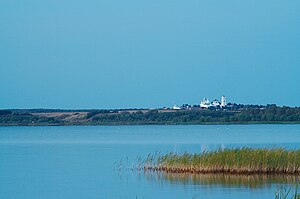Pleshcheyevo lake
| Pleshcheyevo lake | ||
|---|---|---|

|
||
| Geographical location | Yaroslavl Oblast ( Russia ) | |
| Tributaries | Trubesch | |
| Drain | Vjoksa → Nerl → Volga | |
| Places on the shore | Pereslavl-Zalessky | |
| Data | ||
| Coordinates | 56 ° 45 '59 " N , 38 ° 47' 4" E | |
|
|
||
| Altitude above sea level | 137 m | |
| surface | 50.8 km² | |
| length | 9.5 km | |
| width | 6.5 km | |
| Maximum depth | 25 m | |
| Catchment area | 425 km² | |
|
particularities |
National park since 1988 |
|
The Pleschtschejewo Lake ( Russian Плеще́ево о́зеро / Pleschtschejewo osero ) is one of the largest natural lakes in central Russia and is located about 140 kilometers northeast of Moscow in the Yaroslavl Oblast . Due to its scenic location and the high biotope value , the lake and its surroundings have national park status . The old Russian city of Pereslavl-Zalessky , which is part of the Golden Ring, is located on the south-eastern shore of Lake Pleschcheevo around the mouth of the Trubesch .
General
The approximately 5080 hectare, almost oval-shaped lake was created around 30,000 years ago from the melt water of a glacier . The lake is 9.55 km long and up to 6.7 km wide, and about half of it is fed by underground water sources and also by snowmelt water. From November to April, Lake Pleshcheyevo freezes over. The water is home to several valuable fish species, including Coregonus albula (formerly known as “Tsar's herring” and highly valued as a delicacy , still depicted on the city coat of arms of Pereslavl-Zalessky today), perch , ruffle , burbot , pike and various carp fish .
The largest place on the lake is the city of Pereslavl-Zalessky, founded in 1152. In the Middle Ages, there was a large fishing village in the area , which also supplied the Tsar's court with fish from the lake, especially the "Tsar's herring" mentioned above. This fishing village, which has now become a historic district of Pereslavl, has been preserved to this day and is still partly inhabited by fishermen. The Pleschtschejewo-See gained further historical fame when Peter I had a fleet built there in 1692 - the so-called "play fleet", which was used as a test run for the Imperial Russian Navy , which was later built by Peter the Great . A boat built by Peter himself for this mini-fleet at the time, the so-called botik (Russian Ботик), is exhibited in a Pereslavler museum to this day.
Pleshcheyevo Lake National Park
The almost 24,000 hectare area, which includes the lake and surrounding landscape components, was designated as a national park on September 26, 1988 . The largest part of the national park is covered by 15,000 hectares of forest, followed by 6,000 hectares of water, which includes both Lake Pleschtschejewo itself and the surrounding rivers and swamps .
The national park is home to hundreds of plant species, 35 of which are on the Russian Red List . It also provides habitat for 60 species of wildlife - including red deer , roe deer , European flying squirrel , otter , tot shrew - and 210 bird species such as herons , gray goose , whooper swan , bittern , short-eared owl or crane . Some species such as the lynx or the Russian desman are rarely or not at all in the national park. As a biotope, the lake itself has also suffered massively from mass tourism, increasing development and use for windsurfing .
More pictures
Web links
- Pleshcheyevo Lake National Park - official website
- Description on ecotours.ru
- Description on pereslavl.ru
Individual evidence
- ↑ a b Article Pleschtschejewo-See in the Great Soviet Encyclopedia (BSE) , 3rd edition 1969–1978 (Russian)
- ↑ a b Pleshcheyevo Lake in the State Water Register of the Russian Federation (Russian)



